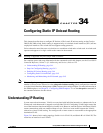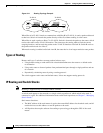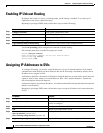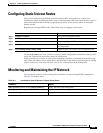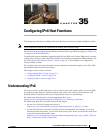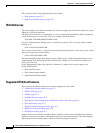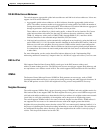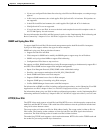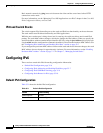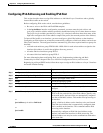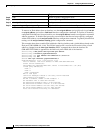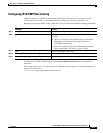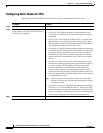
35-3
Catalyst 2960 and 2960-S Switch Software Configuration Guide
OL-8603-09
Chapter 35 Configuring IPv6 Host Functions
Understanding IPv6
128-Bit Wide Unicast Addresses
The switch supports aggregatable global unicast addresses and link-local unicast addresses. It does not
support site-local unicast addresses.
• Aggregatable global unicast addresses are IPv6 addresses from the aggregatable global unicast
prefix. The address structure enables strict aggregation of routing prefixes and limits the number of
routing table entries in the global routing table. These addresses are used on links that are aggregated
through organizations and eventually to the Internet service provider.
These addresses are defined by a global routing prefix, a subnet ID, and an interface ID. Current
global unicast address allocation uses the range of addresses that start with binary value 001
(2000::/3). Addresses with a prefix of 2000::/3(001) through E000::/3(111) must have 64-bit
interface identifiers in the extended unique identifier (EUI)-64 format.
• Link local unicast addresses can be automatically configured on any interface by using the link-local
prefix FE80::/10(1111 1110 10) and the interface identifier in the modified EUI format. Link-local
addresses are used in the neighbor discovery protocol (NDP) and the stateless autoconfiguration
process. Nodes on a local link use link-local addresses and do not require globally unique addresses
to communicate. IPv6 routers do not forward packets with link-local source or destination addresses
to other links.
For more information, see the section about IPv6 unicast addresses in the “Implementing IPv6
Addressing and Basic Connectivity” chapter in the Cisco IOS IPv6 Configuration Library on Cisco.com.
DNS for IPv6
IPv6 supports Domain Name System (DNS) record types in the DNS name-to-address and
address-to-name lookup processes. The DNS AAAA resource record types support IPv6 addresses and
are equivalent to an A address record in IPv4. The switch supports DNS resolution for IPv4 and IPv6.
ICMPv6
The Internet Control Message Protocol (ICMP) in IPv6 generates error messages, such as ICMP
destination unreachable messages, to report errors during processing and other diagnostic functions. In
IPv6, ICMP packets are also used in the neighbor discovery protocol and path MTU discovery.
Neighbor Discovery
The switch supports NDP for IPv6, a protocol running on top of ICMPv6, and static neighbor entries for
IPv6 stations that do not support NDP. The IPv6 neighbor discovery process uses ICMP messages and
solicited-node multicast addresses to determine the link-layer address of a neighbor on the same network
(local link), to verify the reachability of the neighbor, and to keep track of neighboring routers.
The switch supports ICMPv6 redirect for routes with mask lengths less than 64 bits. ICMP redirect is
not supported for host routes or for summarized routes with mask lengths greater than 64 bits.
Neighbor discovery throttling ensures that the switch CPU is not unnecessarily burdened while it is in
the process of obtaining the next hop forwarding information to route an IPv6 packet. The switch drops
any additional IPv6 packets whose next hop is the same neighbor that the switch is actively trying to
resolve. This drop avoids further load on the CPU.



